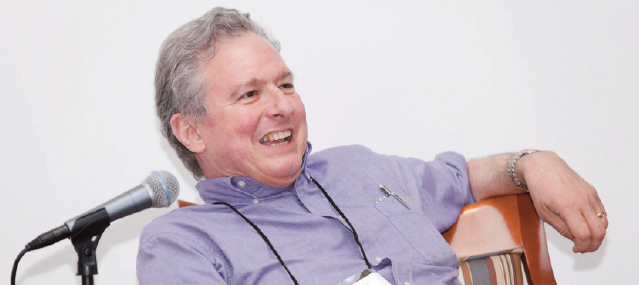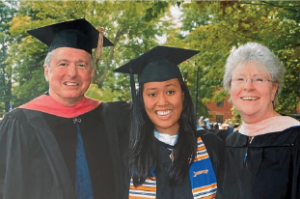Remembering George Cobb (1947–2020)
Allan Rossman and Thomas Moore
An inspiring innovator, George Cobb changed the face of statistics education. He gave this modest branch of our profession a level of respect it had not had before but continues to enjoy. Much as Bob Dylan felt the heat of his era and gave it fuel and oxygen through his ideas and words, George saw teaching statistics as too important for the status quo. Over his lifetime, George showed a remarkable ability to sense the need for (often radical) change and offer a prophetic and eloquent voice for that change. We cherish this self-description George once provided: “Despite his Quaker upbringing, the sight of an apple cart triggers happy fantasies of how to upset it.”
George passed away on May 6, less than a week shy of his 73rd birthday, having been ill for many months. He was a North Carolinian by birth. His father, Whitfield, was a professor of statistics at Virginia Tech and his mother, Polly, taught German and Russian.
He credits his early and enduring interest in mathematics to two wonderful pre-collegiate teachers. He attended Dartmouth, taking nearly enough mathematics for a major and enjoying the influence of John Kemeny and Laurie Snell, who were changing the landscape of mathematics education as George would later do in statistics. But George majored in Russian, because he loved the patterns in Russian poetry. He had a life-long love of word play, which he used so effectively. George’s Dartmouth years foreshadowed a person who would deftly bridge C.P. Snow’s “Two Cultures.”
The Vietnam War derailed George’s plans for graduate study in Russian, and his alternative service as a conscientious objector at the Medical College of Virginia kindled his interest in statistics. Colleagues there convinced him that studying statistics would support his goal of teaching collegiately and his interest in mathematics, while providing marketability in a job search. George earned his PhD at Harvard under Art Dempster, writing his dissertation on conditional inference, and had the privilege of helping Fred Mosteller teach introductory statistics.
George’s first and only job after Harvard was as a faculty member at Mount Holyoke College, where he became the Robert L. Rooke Professor of Mathematics and Statistics and taught from 1974 until retirement in 2009. At Mt. Holyoke, George became beloved and venerated as a colleague, teacher, and mentor.
His writing and leadership garnered similar high regard throughout the statistical world. In the online outpouring of grief and gratitude after his passing, George’s ability to write about statistics was central. Paul Velleman spoke for us all in saying, “George changed the way we thought about teaching and wrote that in ways that were new and stunning to those of us who read him.”
“Stunned” captures how we felt back in 1987 upon reading George’s first major article in statistics education, a book review in JASA titled “Introductory Textbooks: A Framework for Evaluation – A Comparison of 16 Books.” This article constituted a 20-page tour of George’s mind, as much data analysis as commentary—the 16 books as cases, wisely selected variables, and cool graphics like a two-way table of “number of data sets” by “authenticity index.” Stunning in its originality, eloquence, and insight, imbued throughout with George’s humility, this article exhibited qualities that all in the stat-ed community now associate with George.
This article introduced us to George’s aphoristic writing. If one took “George Cobb for $400” on Jeopardy, and the answer was “Judge a book by its exercises, and you cannot go far wrong,” none of us would fail to respond, “What was the take-away message from George Cobb’s 1987 JASA review of textbooks?”
In 1992, George led a focus group of eminent statistics educators that resulted in the chapter “Teaching Statistics” in the MAA volume Heeding the Call for Change. In a 2015 interview for the Journal of Statistics Education, George described his work on this report as “almost exclusively editorial,” but added, “I worked hard at that … because I wanted to turn good ideas into something that would be brief enough, and pithy enough, to be memorable, …”
It would have been memorable even without the first sentence, but that first sentence, well, it stunned us once again and we knew we were in for a great read:
As “Framework” was a call for data analysis as respectable intellectual activity, “Teaching Statistics” added a second key ingredient to modern statistics education—active learning.
George co-authored two articles on the relationship of statistics and mathematics with another giant in our profession, David Moore, for the American Mathematical Monthly. These articles described how differently the two disciplines regard the interplay between context and abstraction, with implications for statistics education.
George upset apple carts through his many keynote conference presentations, as well. Bob Hayden reflected that “George had a rare gift for entertaining people while making them think at the same time. He often told audiences they were doing it all wrong and needed to change, yet they walked out of his talks laughing and smiling.” A stellar example is George’s banquet presentation at the first US Conference on Teaching Statistics. George told the audience that by emphasizing procedures based on the normal distribution, they were teaching a Ptolemaic curriculum for introductory statistics. George argued that “randomization-based inference makes a direct connection between data production and the logic of inference that deserves to be at the core of every introductory course.” The inaugural issue of Technology Innovations in Statistics Education in 2007 published George’s article on this topic, which has achieved seminal status and inspired many teachers to implement randomization-based inference.
George continued to think and write about current challenges facing our profession into his retirement. He wrote the lead article for a 2015 special issue of The American Statistician (TAS) on curricular reform. George’s title took direct aim at another apple cart: “Mere Renovation Is Too Little Too Late: We Need to Rethink Our Undergraduate Curriculum from the Ground Up.” George also contributed to, and provided the opening lines of, the ASA’s influential statement on p-values that appeared in TAS in 2016.
As a teacher, George practiced what he preached and preached what he practiced. We recall talks in which he joyfully shared making homemade slime to teach data transformations or launching gummy bears to teach factorial design, and he loved being part of the stat-ed community that shared such ideas at JSM. George could also take as well as give with aphorisms. As a champion for the liberal arts, George was particularly fond of quoting his Mount Holyoke colleague, Don O’Shea, who said, “Liberal arts colleges are where cutting-edge research from universities is brought into the undergraduate curriculum.” Along these lines, George developed a Markov chain Monte Carlo course for undergraduates, using notes destined for textbook status, but regrettably not quite finished on his passing.
In 1998, George published an innovative textbook on experimental design. Later, he collaborated on a textbook for a second course in statistics. He also co-authored introductory textbooks, including one that features randomization-based inference.
For 30 years, George also served as an expert witness in legal cases. Most involved workplace discrimination, but one case concerned a hospital nurse accused of murdering patients. This case led to an article co-authored with the opposing expert witness for the collection Statistics: A Guide to the Unknown, a collaboration with his courtroom “adversary” evincing George’s Quaker roots.
George served the ASA in many capacities: serving on and chairing committees, serving on editorial boards, and—from 2003–2006—serving as a vice president. He was the first liberal arts college statistician to serve on the Committee for Applied and Theoretical Statistics for the National Academies of Sciences, Engineering, and Medicine. The ASA made him a fellow in 1993 and gave him the Founders Award in 2007. The Boston Chapter named George Mosteller Statistician of the Year in 2016, and he earned the Mount Holyoke Faculty Award for Teaching in 2003. George was the inaugural recipient of the USCOTS Lifetime Achievement Award in 2005, which the organization has renamed the George Cobb Award in Statistics Education.
Whether in print, at a public presentation, through his curricular projects, in a conference or professional gathering, or as a colleague, George never failed to make you think and want to try things out. His writings are still worth reading because, as with most great writers, you get to see into the mind of a genius. Ann Watkins compared George not to a writer but to a composer: “George truly was the Mozart of our profession: profoundly original, lyrical, incomparably influential, and delightfully complex.”
It feels odd and slightly inappropriate to write about George with such an emphasis on his professional life because socializing with him as a friend was such a joy. He loved humor, the outdoors, music, playing the banjo, eating good food, children, friends, and—above all—his family. George’s wife Cheryl is a singer who teaches voice at Mount Holyoke, and his daughter Lee Tae is a doctoral student in media and communications at Temple University.
George also loved to read, with Dickens a favorite, so we will end by recalling the first sentence of David Copperfield: “Whether I shall turn out to be the hero of my own life, or whether that station will be held by anybody else, these pages must show.” May we sheepishly demur on answering that question for this modest man, but also add that if we are talking heroes, well, George, you will always be one of ours.
The Cobb family has established a memorial site for George.




















